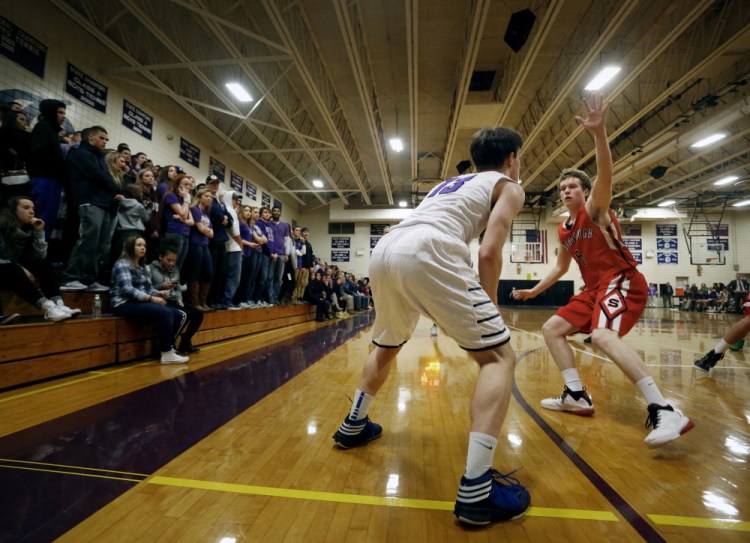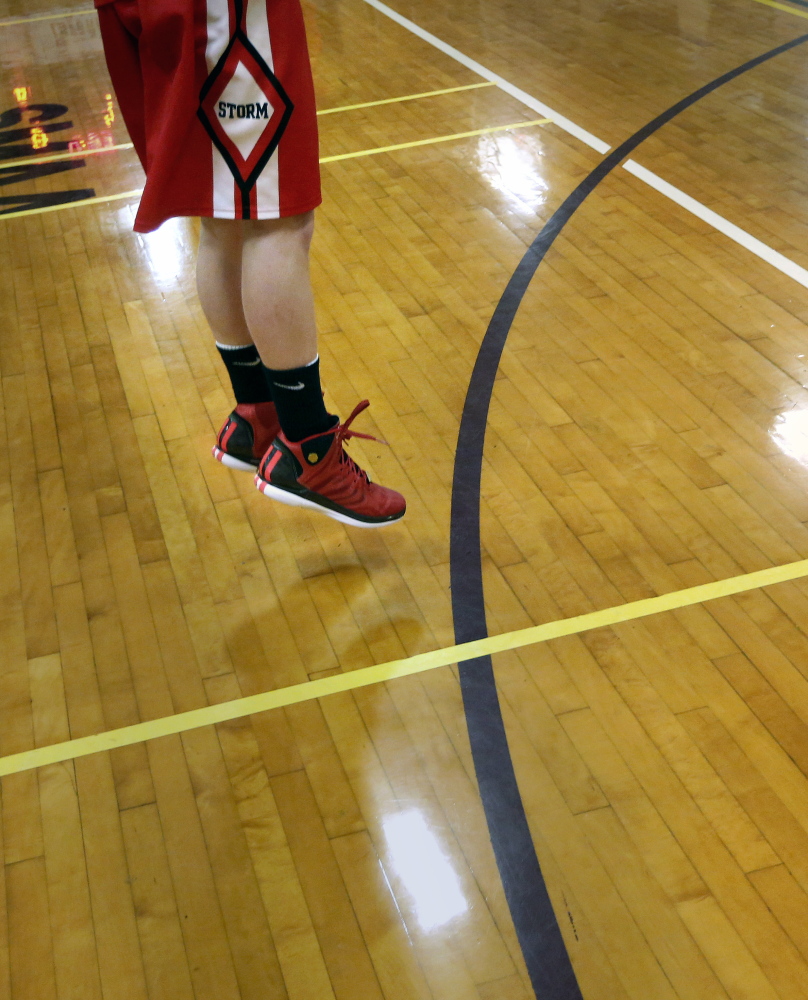Liam Densmore is 5-foot-9. He knew early that if he were to excel in basketball, it wouldn’t come from scrapping for rebounds. So he worked on his jump shot for hours on end at a court near his home.
“I shot every night until my mom made me come inside,” said Densmore, a Portland High senior who tied a school record by making seven 3-pointers in a game this season.
The boys’ high school basketball tournament moves to the Portland Expo for quarterfinal games Friday, and Densmore and the Bulldogs – the top seed in Western Maine Class A – are sure to be among several teams firing away from long range.
High school basketball has featured the 3-point shot – from beyond an arc 19 feet, 9 inches from the basket – for nearly three decades. But boys’ teams in southern Maine are relying on them more than ever, often producing frenetic action.
The best 3-point shooters are becoming more prolific. Eight years ago, only one player in Western Class A averaged as many as two 3-pointers made per game. The next season, there were two.
By comparison, at least seven boys in Western Class A have averaged two 3-pointers made per game in each of the past three seasons, according to data from Michelle Butler, basketball statistician for the Southwestern Maine Activities Association.
“When teams make a few 3-pointers, it adds to the pace of the game,” said Windham Coach Kevin Millington, whose team plays Portland High Friday night. “It becomes a more wide-open game.”
COACHES ON BOARD WITH THE TREND
On Tuesday, Bonny Eagle attempted a whopping 45 3-pointers, making 12 of them, in a preliminary-round loss to Westbrook. The Scots attempted far more 3-point shots this season (522) and last (562) than they did just two winters ago (466).
“You adjust your offense to what your players are best at,” said Bonny Eagle Coach Phil Bourassa. “I would never tell a player not to shoot a 3.”
Westbrook Coach Mike Burke concurred: “Shooting the 3-pointer is a gamble a lot of coaches are willing to take.”
Yarmouth, the No. 1 seed in Western Class B, may feature the most wide-open offense of any team this season. The Clippers have taken an average of 15 3-pointers a game, making seven.
“All of our starting five have a green light to shoot the 3-pointer,” said Coach Adam Smith.
HIGH SCHOOL GAME INFLUENCED BY AAU
Smith and other coaches said the reliance on long-range shooting is hurting other aspects of the game.
“I’m more uneasy with them taking a 12-footer because I feel like it doesn’t have a chance (of going in),” Smith said. It’s a tough shot for kids.
“It’s a skill you have to teach,” he said. “When I look at the shot chart after the game, all the shots are either in the paint or from the 3-point circle. There’s nothing in between. I don’t see the ability to shoot off the dribble or use the glass.”
So for many teams, it’s bombs away.
“We’ll trade a (3-pointer for a 2-pointer) anytime,” said Falmouth Coach Dave Halligan.
Halligan has two of the state’s best 3-point shooters in brothers Thomas and Colin Coyne.
Colin, a sophomore, had to take up the slack for his older brother, who missed much of the season with a broken foot until his return to the lineup in late January. Colin hit a winning 3-pointer at the buzzer to beat Greely early in the season.
During the offseason, the Coynes are among many local high schoolers who play Amateur Athletic Union basketball. The brothers say that brand of the sport – with more focus on individual skills and a wide-open game – has become part of the high school culture.
“In high school, you’re looking to spread the court,” said Thomas. “Players drive and then kick it out for a 3-pointer. Just like in AAU, it’s a big part of the game.”
EMOTIONAL LIFT IN THE FINAL MINUTES
At least one coach believes a lack of tall players is part of the reason that 3-point attempts are becoming more popular.
“There’s not a whole lot of size in Maine,” said Portland Coach Joe Russo. “If there were a lot of big men, teams would look to go down low for the traditional 3-point play.”
But even the “big men” are showing the ability to roam outside and make the 3-pointer. Jack Simonds, a 6-foot-6 senior headed for Bowdoin College, has been doing that for the past four seasons at Falmouth. Simonds surpassed 1,000 career points in his final regular-season game last week.
Whoever might be firing it up, the 3-point shot also can provide an emotional lift – especially toward the end of games.
“If you hit two or three in a row, it’s huge,” said Russo. “A seven-point deficit in the final two minutes is not so big.”
Jamie Russell, the coach at Piscataquis Community High School in Guilford, can attest to that. His team had a nine-point lead with 57 seconds left in regulation against Central High of East Corinth early in the season.
“They hit three 3-pointers in 57 seconds and we lost in overtime,” Russell said. “In my first two years of coaching, there wasn’t the 3-point line. It’s tougher to put teams away.”
Send questions/comments to the editors.




Success. Please wait for the page to reload. If the page does not reload within 5 seconds, please refresh the page.
Enter your email and password to access comments.
Hi, to comment on stories you must . This profile is in addition to your subscription and website login.
Already have a commenting profile? .
Invalid username/password.
Please check your email to confirm and complete your registration.
Only subscribers are eligible to post comments. Please subscribe or login first for digital access. Here’s why.
Use the form below to reset your password. When you've submitted your account email, we will send an email with a reset code.